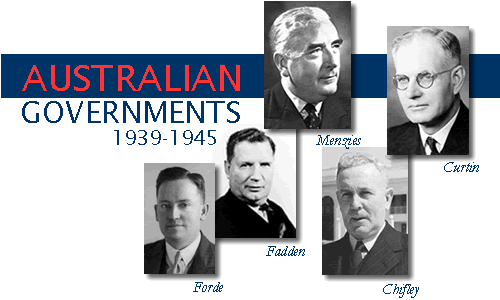
During the official wartime period, Australia had five prime ministers - Robert Menzies, Arthur Fadden, John Curtin, Frank Forde and Ben Chifley.
Australian governments in the lead-up to war
In the federal elections held in October 1937, the United Australia Party (UAP) - Country Party Coalition Government was returned to office, winning 43 seats in the House of Representatives (27 UAP and 16 Country Party). The Australian Labor Party (ALP), led by John Curtin, won 29 seats and two seats were won by conservative Independents. In the Senate Labor made gains, winning 16 seats, while the UAP won 3; from July 1938 the Senate had 20 coalition and 16 ALP Senators. Joseph Lyons, as leader of the UAP, the larger party in the coalition, was Prime Minister. The Deputy Leader of the UAP, Robert Menzies, served as Attorney-General and Minister of Industry while Earle Page led the Country Party.
On 20 March 1939 Menzies resigned from the coalition ministry in protest at Cabinet's decision, under pressure from the Country Party, to repeal the pension provisions in the recently passed National Insurance Bill. Menzies was thus a backbencher when less than a month later, on 7 April, Prime Minister Joseph Lyons suddenly died. Lyons had driven from The Lodge in Canberra to Sydney, when he suffered a heart attack, dying in hospital in Sydney on Good Friday.
Deputy Prime Minister Earle Page formed an interim administration until the UAP, lacking a deputy leader due to Menzies' resignation, could elect a new leader. In the party room meeting of 18 April 1939, Menzies was elected leader of the UAP and two days later in Parliament, Page launched a vitriolic attack on Menzies, giving vent to the years of political hostility and personal bitterness between the two men.
Page refused to serve in a government headed by Menzies and withdrew the Country Party from the coalition. The new government which took office on 26 April consisted only of UAP members and relied on Country Party support to remain in office.
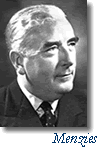
Prime Minister Robert Menzies
26 April 1939 to 28 August 1941
Minority United Australia Party Government
26 April 1939 to 14 March 1940
When war broke out in September 1939, Robert Menzies was Prime Minister of Australia, heading a minority UAP Government. He had been leader for just over four months when, in a radio broadcast at 9.15 pm on Sunday 3 September, he informed the Australian people that ‘in consequence of a persistence by Germany in her invasion of Poland, Great Britain has declared war upon her, and that, as a result, Australia is also at war’.
With the coming of war, Earle Page offered Country Party support to form a composite government but Menzies refused, unwilling to allow Page a role in the Cabinet. The Country Party elected Archie Cameron as leader soon after but it was not until 14 March 1940 that a UAP-Country Party Coalition Government was formed, after the government had lost a by election to Labor following the resignation of Richard Casey to become Australia’s first ambassador to Washington. Cameron acceded to Menzies' right to final say over who would hold Cabinet posts.
United Australia Party-Country Party Coalition Government
14 March 1940 to 28 August 1941
The Menzies Coalition Government was seriously weakened in August 1940 when three senior ministers were amongst those killed when a Royal Australian Air Force plane crashed while approaching Canberra’s airfield. The ministers, James Fairbairn, Henry Gullett and Geoffrey Street, were strong and loyal supporters of Menzies.
The political situation changed dramatically after the federal election held some five weeks later on 21 September. Following the ballot the ALP and the Coalition parties (23 UAP and 13 Country Party) each held 36 seats in the House of Representatives, leaving two Victorian Independents, Alex Wilson and A.W. Coles, holding the balance of power. In the Senate, the UAP and Country Party won 16 Senate seats and Labor won 3; from July 1941 the Senate had 19 government and 17 Labor Senators.
Menzies had hoped for a clear decision but the Coalition Government now relied on the support of the two Independents to remain in office. ALP leader John Curtin, while supporting the war effort, resisted Menzies' offers to form an all party national government. Menzies was forced to make compromises in his ministry, with Earle Page taking on the position of Minister for Commerce. Menzies also reluctantly accepted Curtin's proposal for the establishment of an Advisory War Council on which Government and Opposition would have equal representation, and which the Government could inform and consult on all matters to do with the conduct of the war.
In the wake of the federal election, Archie Cameron lost the Country Party leadership and in October 1940, Arthur Fadden became acting leader, also taking on the role of Treasurer. He was confirmed as leader of the Country Party on 12 March the following year.
Menzies left for London in late January 1941, returning to Australia in May and Fadden was acting Prime Minister over this four month period. On Menzies return, he found the coalition deep in political intrigue. Under pressure from his own party and his coalition partner to resign, he he stood down as Prime Minister and as leader of the UAP on 28 August 1941. WM Hughes replaced Menzies as UAP leader and a joint UAP-Country Party meeting chose Arthur Fadden to lead the Coalition government. Fadden was sworn in as Prime Minister the next day.
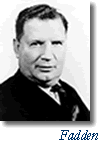
Prime Minister Arthur Fadden
29 August to 7 October 1941
United Australia Party-Country Party Coalition Government
29 August to 7 October 1941
The UAP-Country Party Coalition Government continued in office with the minority party now providing the leader. Prime Minister Fadden's Government however lasted only 40 days. On 3 October 1941 it was defeated during the budget debate on a no confidence motion when the two Independents, Wilson and Coles, crossed the floor to vote with Labor. Fadden was unable to retain majority support in the House of Representatives and he advised the Governor-General that ALP leader John Curtin should be commissioned as Prime Minister.
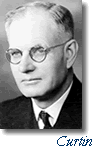
Prime Minister John Curtin
7 October 1941 - 5 July 1945
Minority Australian Labor Party Government
7 October 1941 to 21 August 1943
Curtin was sworn in as prime minister on 7 October but without a majority in either House of Parliament, though the position was eased a little when the non Labor Speaker and Chairman of Committees in the House of Representatives, W M Nairn (UAP) and JH Prowse (Country Party), both agreed to remain in those positions.
However, party political matters returned to the forefront in 1943 when the threat of invasion by Japan was significantly diminished. On June 21 Nairn and Prowse resigned ahead of a no confidence motion against the Curtin Government. Aided by Coles’ vote, the Labor Government survived by the narrow margin of 27 votes to 26.
Australian Labor Party Government
21 August 1943 to 5 July 1945
Labor's position improved dramatically with the Curtin Government's landslide win in the federal election of 21 August giving Labor 49 seats in the House of Representatives to the Coalition’s 23 (14 UAP and 9 Country Party) and two Independents (Coles and Wilson). In the Senate, the ALP won all 19 Senate seats contested; from 1 July 1944 the ALP had 22 Senate seats to 14 for the Coalition, the first time since the conscription split in 1916 that Labor had controlled both Houses of the Commonwealth Parliament.
Curtin's health deteriorated in his last year as prime minister. He suffered a coronary occlusion in November 1944, resumed official duties in late January 1945 and was unwell again from late April. While he lived to see the end of the War in Europe, Curtin died on 5 July 1945, some six weeks before the end of the War in the Pacific. Deputy Leader Francis Forde took over the prime ministership until the ALP Caucus elected Joseph Chifley as leader.
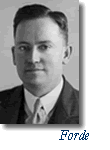
Prime Minister Francis Forde
6 July 1945 to 13 July 1945
Australian Labor Party Government
6 July 1945 to 13 July 1945
Frank Forde was Prime Minister for only eight days, from 6 July to 13 July 1945, the shortest term for any Australian prime minister.
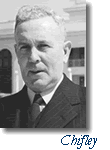
Prime Minister Ben Chifley
13 July 1945 to 19 December 1949
Australian Labor Party Government
13 July 1945 to 19 December 1949
Following his election with an absolute majority over three other candidates as Labor leader by the ALP Caucus, Joseph (Ben) Chifley was sworn in as Prime Minister on 13 July 1945, leading the nation for the final weeks of World War Two. After the surrender of the Japanese, he was able to announce to the Australian people on 15 August 1945 'Fellow citizens, the war is over'.
In federal elections held on 28 September the following year, the Chifley Labor Government was returned to power with a slightly reduced majority in the House of Representatives (the ALP held 43 seats instead of 49). In the Senate, the ALP held all but 3 of the 36 Senate seats from 1 July 1947.
Chifley remained head of the Labor Government until his resignation on 19 December 1949 in the wake of his party’s electoral defeat by the Liberal Party under Robert Menzies in the federal elections held 9 days earlier.